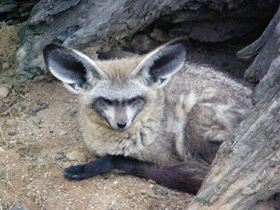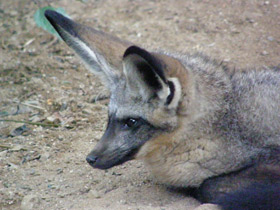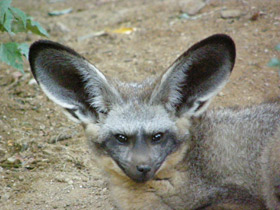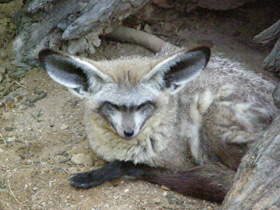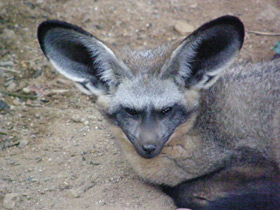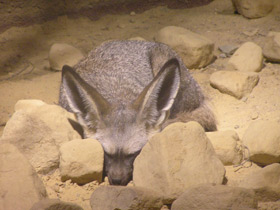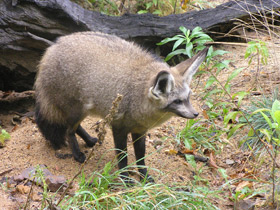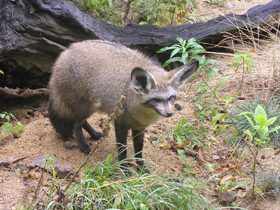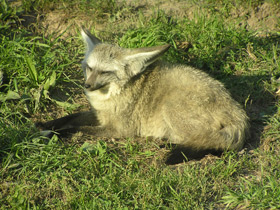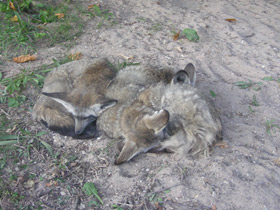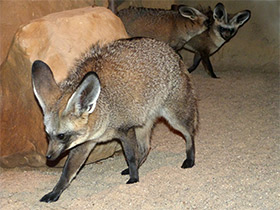The bat-eared fox (Otocyon megalotis)
The bat-eared fox (Otocyon megalotis) is a species of fox found on the African savanna. It is the only extant species of the genus Otocyon and considered a basal canid species. Fossil records indicate this canid first appeared during the middle Pleistocene.
It is named for its large ears, which have a role in thermoregulation. The bat referred to in its colloquial name is possibly the Egyptian slit-faced bat (Nycteris thebaica), which is abundant in the region and has very large ears. Although not commonly used, other vernacular names include big-eared fox, black-eared fox, long-eared fox, Delalande's fox, cape fox, and motlosi.
Systematics and evolution
The bat-eared fox is the only living species of the genus Otocyon. Its scientific name, given by Anselme Gaëtan Desmarest, was initially Canis megalotis (due to its close resemblance to jackals), and later changed by Salomon Müller which placed it in its own genus, Otocyon; its huge ears and different dental formula warrant inclusion in a genus distinct from both Canis and true foxes (Vulpes). The generic name Otocyon is derived from the Greek words otus for ear and cyon for dog, while the specific name megalotis comes from the Greek words mega for large and otus for ear.
Due to its different dentition, the bat-eared fox was previously placed in a distinct subfamily of canids, Otocyoninae, as no relationship to any living species of canid could be established. However, according to more recent examinations, this species is regarded as having affinities with the vulpine line, and Otocyon was placed with high confidence as sister to the clade containing both the raccoon dog (Nyctereutes) and true foxes (Vulpes), occupying a basal position within Canidae.
Subspecies
Currently, there are two recognized subspecies:
- Otocyon megalotis megalotis (Desmarest, 1822) — found in southern Africa;
- Otocyon megalotis virgatus (Cabrera, 1910) — found in eastern Africa.
Fossils
Otocyon is poorly represented in the fossil record. It is suggested the genus forms a clade with Prototocyon, an extinct genus of canid. However, the generic distinction between Prototocyon and the extant Otocyon is doubtful. Fossils of an extinct fox-like canine known as Otocyon recki, have been found in sediments of the Olduvai Gorge, Tanzania, dating back to the late Pliocene or early Pleistocene. However, it is now often placed in Prototocyon.
Description
Otocyon megalotis is a species of carnivorous mammal of the family Canidae.
The scientific name of this animal translates from Greek as "big-eared dog". Otocyon megalotis is so unique that it forms its own genus Otocyon. This inhabitant of the African continent is notable for its large, 15 cm long, cup-shaped ears.
Otocyon megalotis resembles the common fox, but is smaller: its length is 46 to 66 cm and its height at the withers is about 40 cm and its weight is 3 to 5.3 kg. It has a short, tapering muzzle and a long tail (24-34 cm). The coat of Otocyon megalotis is of medium height, generally greyish-yellow with brown, silvery-grey and yellow flecks; the throat and belly are lighter in colour; the tips of the legs and ears are black; the tail has a black band and a raccoon-like "mask" on the muzzle.
Nutrition and habitat
A distinctive feature of this species is its dental system, which has 48 teeth, including 4 premolars and 4 molars in each half of the jaw. This is the maximum number of teeth for terrestrial placental mammals. The teeth of this fox are small and the bite is weak, which is explained by the peculiarities of its diet.
The fact is that Otocyon megalotis is the only member of the dog family that prefers insects to the usual meaty diet of predators. Over many years of evolution, its teeth have been modified, becoming small and weak and adapting to a less strenuous diet than mammalian meat and fur.
Its favourite foods are ripe fruits, roots, termites, spiders, scorpions and, on rare occasions, lizards and small mammals. What Otocyon megalotis has lost in jaw strength, it has more than made up for in its ability to chew food quickly. This useful quality helps them to satiate small prey such as beetles and termites: the faster you chew, the more time you have to swallow.
In a year, for example, Otocyon megalotis eats around 1.15 million termites.
A fox's main weapon in the search for food is its ears. They are like locators that detect the slightest movement of beetles and can even hear the subterranean rustling of bee larvae and termites emerging from their holes. Determining by sound where its prey is, Otocyon megalotis will leap up, spend a few seconds digging up an insect, and then receive a reward in the form of juicy termite larvae or millipedes.
These little foxes can travel some twelve kilometres in a night in search of food. Their ears are lined with blood vessels that act as thermoregulators, preventing them from overheating in the semi-arid open plains and savannah. Surprisingly, these small furry hunters live in two distinct and isolated areas of Africa: in the east, from Sudan to mid-Tanzania, and in the south, from Angola to South Africa. This distribution is due to the habitat of their main food, the herbivorous termite species Hodotermes mossambicus. The diet of the eared fox consists mainly of insects and their larvae: 50 % are termites, the rest are beetles and locusts; less than 10 % are lizards, small rodents and birds' eggs. Foxes occasionally feed on plants; they do not attack domestic animals. They obtain their moisture from the liquids contained in their food.
Otocyon megalotis often stays near herds of large ungulates (zebras, wildebeest), because it lays eggs in their dung beetle droppings, which they like to digest.
Social behaviour and reproduction
Otocyon megalotis is monogamous, but occasionally there are families with one male and two females. They hunt one at a time; only in food-rich areas can several animals be seen hunting within a few metres of each other. The size of the range depends on food abundance and varies from 0.25 to 1.5 km²; it is often unmarked.
In some parts of South Africa the population density of Otocyon megalotis reaches 28 individuals per km². They live in burrows, building entire labyrinths underground with wide corridors and multiple entrances and exits.
To escape pursuit, Otocyon megalotis often runs into tall grass and then suddenly changes direction, as if turning on one of its forelegs, which allows it to keep up speed and hide safely in its burrow. Pregnancy lasts 60-70 days in these foxes. The grey fur-covered cubs (2-6) are usually born between December and April, which is the peak of the insect population. A female either gives birth in an old burrow, which has been in use for several years, or digs a new burrow. In family groups, the young are fed by all lactating females. The male helps to raise them and guards the den while the mother goes hunting. The foxes' eyes open on the 9th day and they emerge from the den on the 17th day; they feed on milk until 15 weeks of age, after which they begin to hunt with the adults. At 5-6 months of age, young foxes become independent and often leave their parents during the breeding season; some females, however, may remain in the family group.
Life history
Otocyon megalotis inhabits dry savannah and semi-desert areas, sometimes near human settlements. Their activity is mainly nocturnal, but in South Africa these predators are nocturnal in winter and nocturnal in summer. During the day, foxes hide in burrows, thickets or in termite holes dug by the pipistrelle.
Dentition
The teeth of the bat-eared fox are much smaller and reduced in shearing surface formation than teeth of other canid species. This is an adaptation to its insectivorous diet. The bat-eared fox is an old species that was widely distributed in the Pleistocene era. The teeth are not the bat-eared fox's only morphological adaptation for its diet. On the lower jaw, a step-like protrusion, called the subangular process, anchors the large digastric muscle to allow for rapid chewing. The digastric muscle is also modified to open and close the jaw five times per second.
Foraging
Bat-eared foxes usually hunt in groups, often splitting up in pairs, with separated subgroups moving through the same general area. When termites are plentiful, feeding aggregations of up to 15 individuals from different families occur. Individuals forage alone after family groups break in June or July and during the months after cub birth.
Prey is located primarily by auditory means, rather than by smell or sight. Foraging patterns vary between seasons and populations, and coincide with termite availability. In eastern Africa, nocturnal foraging is the rule, while in southern Africa, nocturnal foraging during summer slowly changes to an almost solely diurnal pattern during the winter. Foraging techniques depend on prey type, but food is often located by walking slowly, nose close to the ground and ears tilted forward. It usually occurs in patches, which match the clumped prey resources, such as termite colonies, that also occur in patches. Groups are able to forage on clumps of prey in patches because they do not fight each other for food due to their degree of sociality and lack of territoriality.
Conservation threats
The bat-eared fox has some commercial use for humans. They are important for harvester termite population control, as the termites are considered pests. They have also been hunted for their fur by Botswana natives. Additional threats to populations include disease and drought that can harm populations of prey; however, no major threats to bat-eared fox populations exist.










